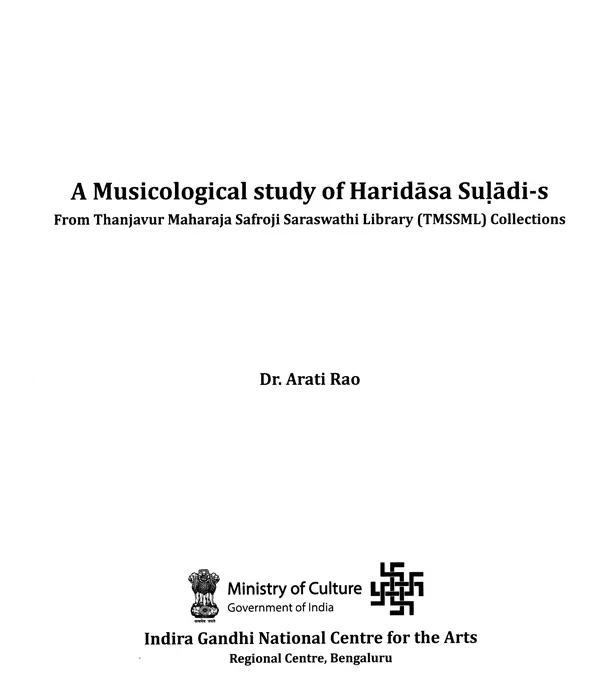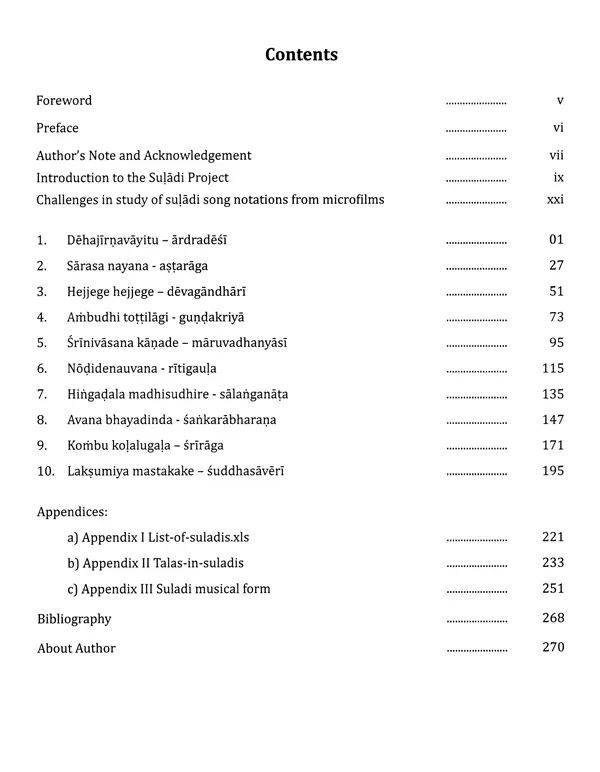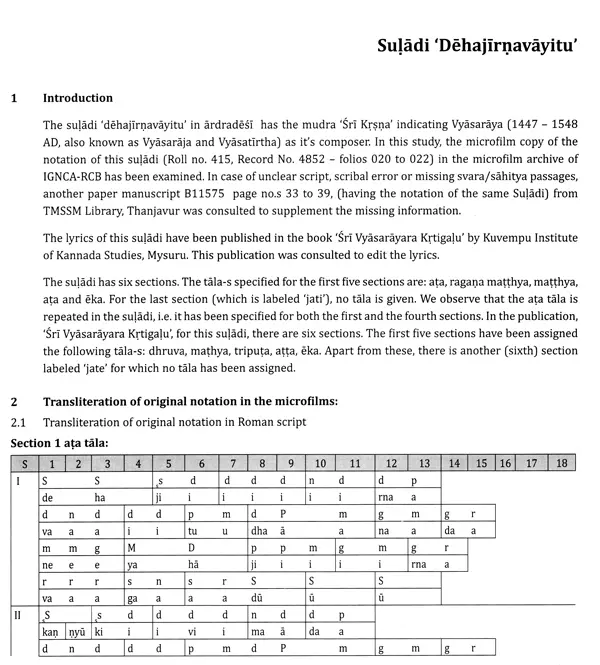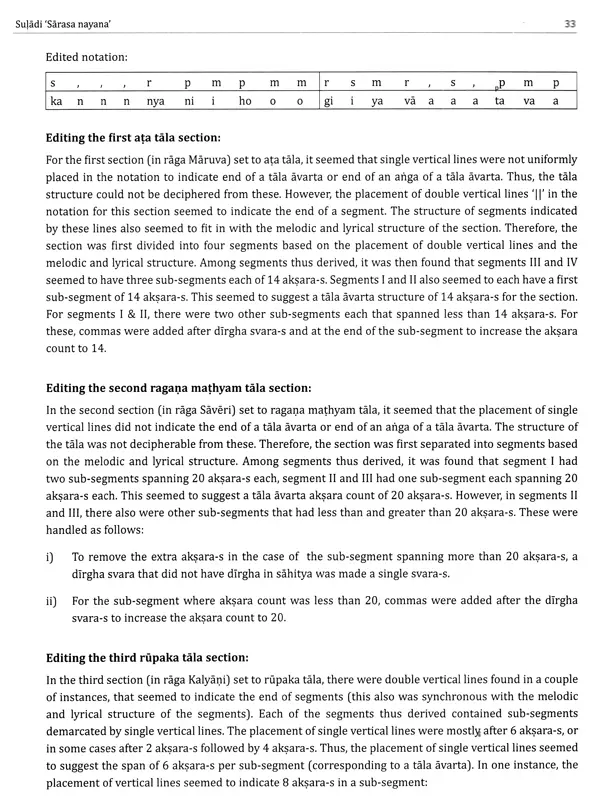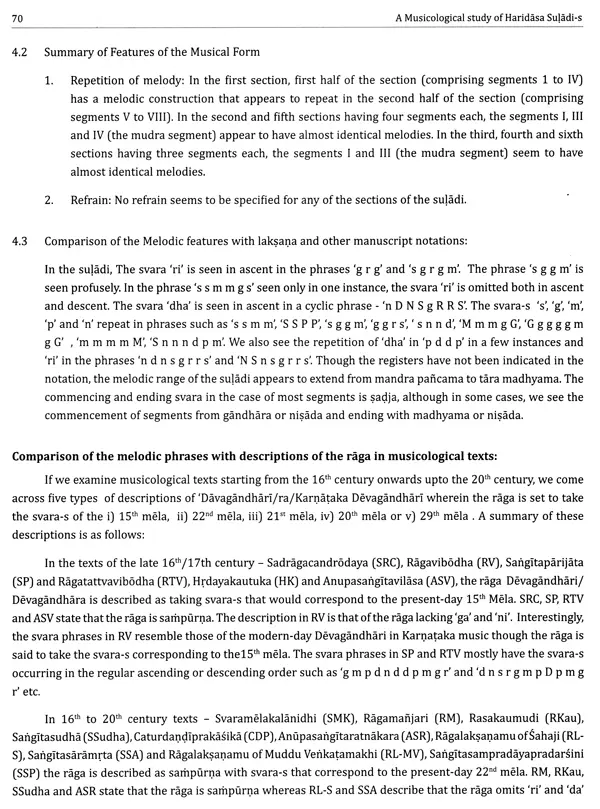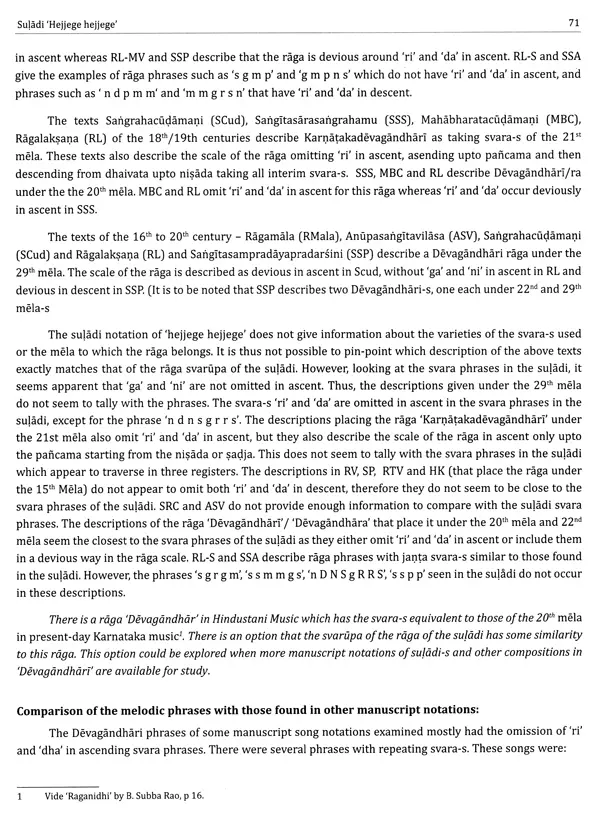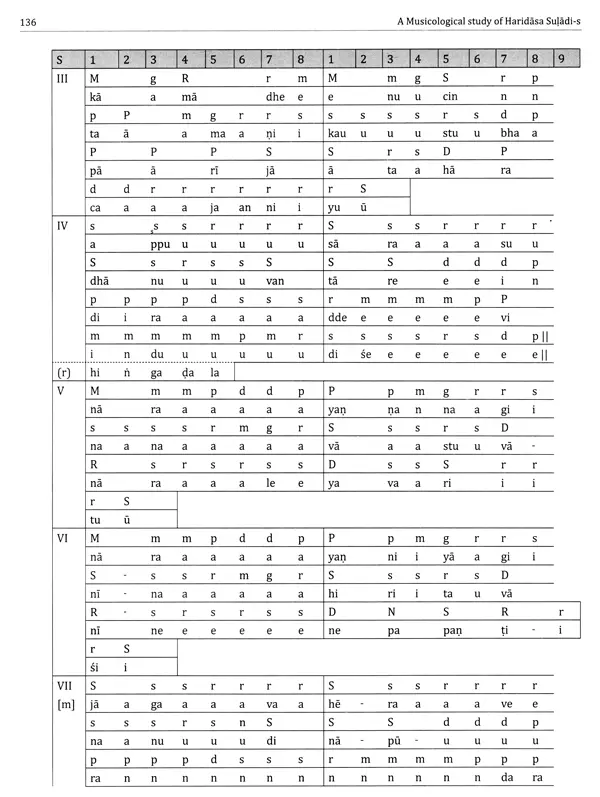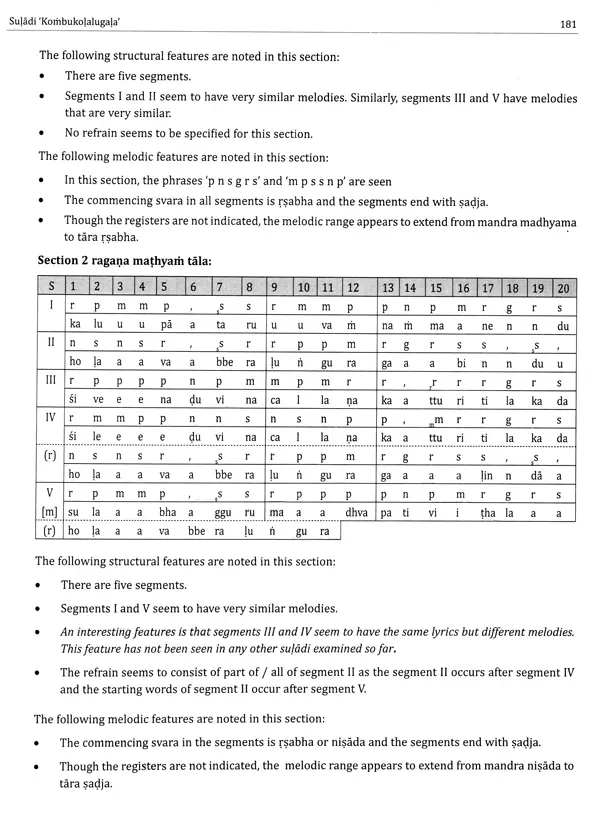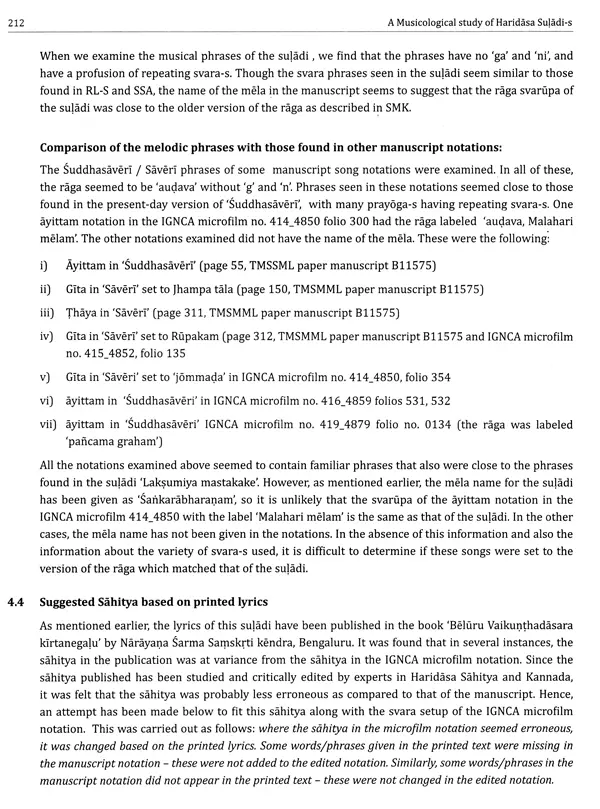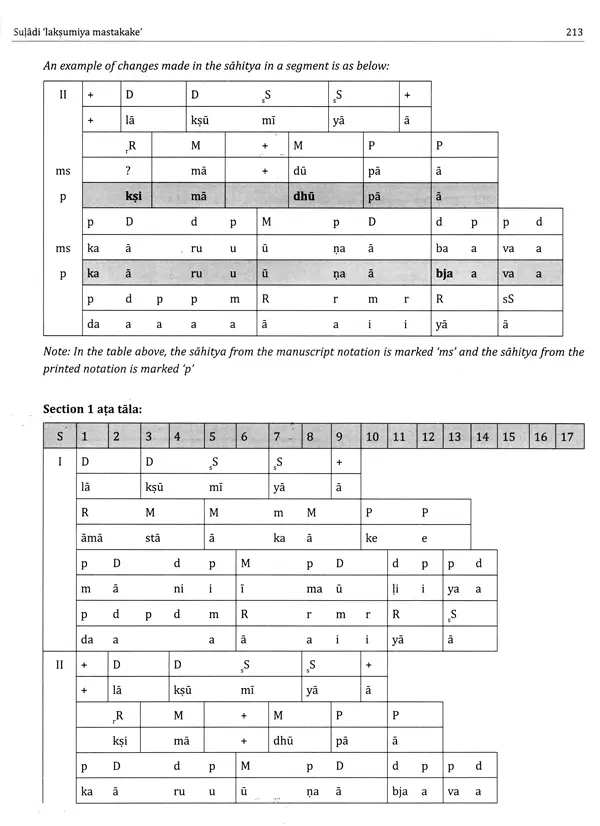
A Musicological Study of Haridasa Suladi-s (from Thanjavur Maharaja Safroji Saraswati Mahal Library (TMSSML) Collections)
Book Specification
| Item Code: | UAT992 |
| Author: | Arati Rao |
| Publisher: | Indira Gandhi National Centre for the Arts |
| Language: | English |
| Edition: | 2022 |
| ISBN: | 9789391045135 |
| Pages: | 296 |
| Cover: | PAPERBACK |
| Other Details | 11.00 X 8.50 inch |
| Weight | 860 gm |
Book Description
Musical Notations of Suladi songs of Haridasa saints of the 15th-17th century are scarce. Some of these are found in palm leaf manuscripts in the Thanjavur Maharaja Serfoji's Saraswathi Mahal Library (TMSSML), copies of which exist in the microfilm archive of the Indira Gandhi National Centre for the Arts, Southern Regional Centre (IGNCA, SRC), Bengaluru. This book is the outcome of a research project on these Suladi songs. Musical notations of ten Suladi songs present in microfilm copies of IGNCA, SRC, Bengaluru were taken up for this study.
In the book, for every song, the original manuscript notation in Telugu script along with the transcription of the notation in Roman letters has been given. This is followed by the edited version of the notation, along with a description of the methodology of the editing. The suladi songs have been studied from three perspectives: raga, täla and musical form. For each suladi, raga phrases from the notation have been compared to those of other manuscript song notations in the same raga and musicological descriptions of the raga. The general, trends seen in tåla in the ten song notations have been studied with respect to the description of suladi tala-s seen in musicological descriptions of the early 17th century. The general features of the suladi musical form as seen in the ten notations have been examined in comparison with descriptions in musicological treatises (laksana grantha-s).
A critical study of musical notations documented in manuscripts of yore is crucial to understanding the volution of musical formu, complexity and elements of performance. The history of Carnatic music is layered musical enterprise separated in time and space across South India and its transmission has been both oral and written. Haridasa Suladis in South India have been preserved as ritual songs attached to temples and sacred Madhwa Mathas (religious centres propagating the Dwaitha philosophy) and transmitted orally amongst many specific communities in South India. As a musical genre, the Suladi is significant as a compositional model, touted to have been the basis of a whole family of metric taalas called Sulaadi Sapthathaalas. Such a study is also significant in highlighting the seminal contributions of Haridasas; wandering bards who interpreted ancient knowledge in lucid song so that the essence of Indian knowledge systems enlivens everyday life even the non-scholar. The Haridasa movement revitalized Carnatic music's pedagogy and performance practices, it is also known as a period of prolific composers who laid the foundations for modern Carnatic compositions to emerge in the 19th century.
Manuscript based studies in music have to tread the tightrope walk of reconciliatory approaches to the written, ascribed and non-ascribed errors, changes in musicological attitudes, conventions and ever-changing Raapa grammar. In this book, an honest attempt has been made to describe the methodology and conflicts if any in musicological interpretation of the song. Time and taala approaches employed have been studied and compared with musicological descriptions of the early 17th century. The general features of the sujadi musical form as seen in the ten notations have been examined in comparison with descriptions in musicological treatises (laksana grantha-s). Such a publication has immense revival value, by bringing back Suladis in performance, in Carnatic pedagogical syllabi and by providing curated notations for the Carnatic teacher looking to expand repertoire. The Regional Centre. Bengaluru is delighted to have housed such a study that makes use of its large microfim repository. We are hopeful that such a study will inspire research and scholarly engagements with our cultural repositories in the future.
I am grateful to Dr. Deepti Navaratna, former Regional Director, IGNCA RCB, for all her efforts in bringing out this book in current shape.
Indian music has seen many phases of seminal changes. South Indian music has been greatly influenced by philosophers, thinkers and saints, who have composed a large corpus of songs that have formed the backbone of Indian classical music. The influence of Haridasa saints of South India to the music of this region is a case in point. Though the main objective of the Haridasa-s was to promote "bhakti, they made very significant contributions to South Indian music through their songs, which were vehicles for the propagation of moralistic and philosophical tenets Many Haridasa songs are performed by the practitioners of Karnataka Classical Music today, but these are mainly dasara pada-s and ugåbhoga-s. Suladi songs, which form a large part of the compositions of Haridasa-s are not in vogue at all. These songs not only showcase dharmic concepts but were an important part of South Indian classical music between the 15th and 19th century. Today, the authentic music of these songs is all but lost, and the only reliable sources for these are the palm leaf manuscripts preserved in the Thanjavur Maharaja Serfoji's Saraswathi Mahal Library. A thorough study of the musical information contained in these manuscripts would help reconstruct the music of South India in the medieval period. In this context, this book, which is based on the study of suladi songs, is a significant contribution to research in South Indian music.
One of the important objectives of the Indira Gandhi National Centre for the Arts is to facilitate and promote research in Indian culture. In the 1990s, IGNCA executed a pioneering project of microfilming a very large number of manuscripts across libraries in various parts of the country. These microfilms are a goldmine for researchers who are working on varied subjects related to Indian culture such as music, literature, philosophy, mathematics, architecture, Ayurveda and the like. IGNCA, Regional Centre Bengaluru, has an extensive microfilm repository of many of these microfilms that are easily accessible to researchers. Dr. Arati Rao's project is the first of it's kind in Indian Music that has been carried out by the intensive study of microfilms from the IGNCA repository. She has done commendable research carrying out an in-depth study of the musical notations of the songs in the microfilms against the background of musicological treatises of their time.
The vast microfilm collection of IGNCA offers many possibilities of manuscript-based research- in future, perhaps a large number of such research projects will be carried out using this invaluable source.
1. Objective and Scope of the project
The objective of this project was to study the musical features of sulidi songs pertaining to raga, tala and musical form from notated manuscript coples available on microfilm at the IGNCA-RCB sourced from Thanjavur and other manuscript libraries as a part of the Kalasamälöcana initiative of the IGNCA The scope of the project was limited to the musicological study of the Kannada suladi-s of Haridasa-s composed between the 15 century AD to the 19 Century AD based on microfilms found in the archives of IGNCA-RCB. The thrust of this project was to bring to light suladi songs from the microfilm notations and present them with necessary academic background. The aspects of musical form, raga and täla quite often demand a much deeper analysis. But undertaking that in this project would make it too large and could shift the focus of the project. Hence, only a preliminary analysis of these aspects (based on the information gathered from the manuscript notations) has been attempted in this project.
2. Suladi songs of Haridasas - Introduction
Suladi-s are classical compositions with devotional lyrics that came into being when the Vijayanagara Empire was at its zenith in South India (1336 AD to 1565 AD). Vaisnava Haridasa saints such as Sripadaraya, Vyasaraya and Purandara Dasa composed many suladi-s in Kannada which had several sections, each set to a different Tala and having a nom de plume (called Ankita/Mudra) of the composer. The Tala-s used were: dhruva, ragana-matthya, matthya, rupaka, ata, Jhampe, triputa, ēka and âdi. It was not mandatory to have all the tala-s in a Suladi. The final section was short and called 'Jate/Jati which thematically summarized the composition.**Contents and Sample Pages**
